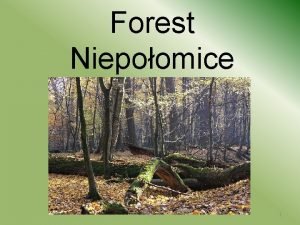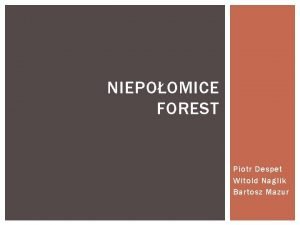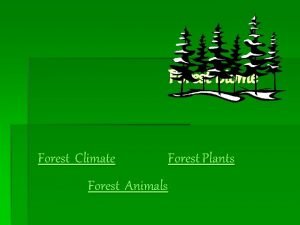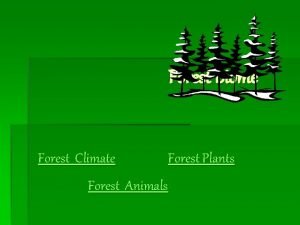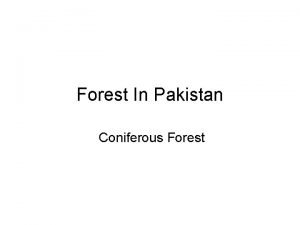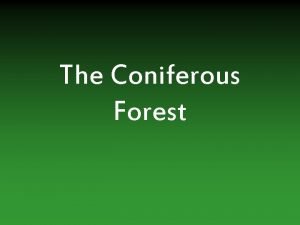The Niepoomice Forest Presentation prepared for YPEF European













- Slides: 13

The Niepołomice Forest Presentation prepared for YPEF European contest about forests and forestry Authors: Krystyna Mokrzycka Karolina Oluszczak 2 b Magdalena Trojanska VIII LO Krakow 2 d 2 k

The site The Niepołomice Forest is located about 20 kilometres east of Krakow on the Vistula lowland in the fork of the Vistula and Raba rivers. It is the largest area of the city forest complex. The forest occupies the area of approximately 110 square kilometres. In its northern part the complex is crossed by the Drwinka river valley, accompanied by the wide strip of meadows. The Niepołomice Forest is dominated by pine forest of artificial origin, but there also larger patches of natural hornbeam, alder and riparian woods. Nature The nature reserves in the Niepołomice Forest play an important role in protection of the rare or endangered species of plants and animals as well as in preserving the diversity of species in the whole area. The most valuable species in terms of nature as follows: the Ural Owl (Strix uralensis), the Black Stork (Ciconia nigra) and moose (Alces). There has been also a breeding center for European bison (wisent) since 1925. Today, the Niepołomice Forest is considered the most magnificent forest complex in the Małopolska Province and it is often called ‘the green lungs of Krakow’. The Niepołomice Forest Inspectorate is responsible for the area. The Niepołomice Forest was included in the Natura 2000 programme.

History In 13 th century the Niepołomice Forest became a part of the royal estate to serve as a hunting ground for large animals like wisents, bears, wolves and aurochs (now extinct). Later on, in the mid-14 th century, king Kasimir the Great built a Gothic church and a hunting castle on the Vistula river, thus contributing to foundation of Niepołomice. The kings from Jagiellonian Dynasty continued hunting for deer, the wild boar, the elk and the bear. The forest was also a source of wood for the royal court. It all contributed to the deterrioration of the Niepołomice Forest. Sigismund II August was the only king who protected the wildlife of the Niepołomice Forest by issuing a ban on the wisent hunting. Breaking the law was punished. Nobody, except for the king, could hunt the bison on pain of death. One of the most famous hunting in the Niepołomice Forest, lasting for three days, origin was organised by king August II of Saxon Dynasty. 150 pieces of large game were The of the name killed and the oak, under which the king spent the night, was fenced and a special plaque The name ‘Niepołomice’ thetree Oldwas Polish language word ‘niepołomny’ which means mentioning the event wasderives put on from it. The named the ‘August’s Oak’, ‘impossible to overcome and destroy or deforest’. Thus, in the past Niepołomna Forest used to be a piece of the wildland which was difficult to grub and make agriculturally productive.

Benefits About 54% of harvested timber comes from felling cuts while the remaining 46% comes from treatments such as: cleaning and thinnig. Raw coniferous makes up almost 60% of harvested wood and hardwood provides 40% of it. It is a result of a considerable share of the pine (Pinus silvestris) stands. The Niepołomice Forest district supply of wood makes up 2 817 776 cubic metres with the average wealth 277 cubic metres per ha.

Flora Habitat types occurring in the Niepołomice Forest are: moist mixed forests with a predominance of pine and spruce, humid forest with pedunculate oak (Quercus robur) mixed humid forest Among the trees species we can find: larch, alder, beech, ash, hornbeam, birch, linden, elm, poplar and fir. Forest can be divided into a northern part (more diverse in terms of the number of plantfollowing species)species and southern The ocurringpart. in the forest are legally protected: common ivy (Hedera helix), European wild ginger (Asarum europaeum), sweetscented bedstraw (Galium odoratum), spiked rampion (Phyteuma spicatum).

Protected species: Phyteuma spicatum Hedera helix

Common species The most common species found in the Niepołomice Forest are: European spindle (Euonymus europaeus), Corydalis solida, Euonymus verrucosus Scop, lesser celandine (Ficaria verna), tussock cottongras (Eriophorum vaginatum), dog's mercury (Mercurialis perennis), small cranberry (Vaccinium oxycoccos), ground elder (Aegopodium podagraria) Eriophorum vaginatum Euonymus verrucosus

Interesting species found in the forest: Cardaminopsis halleri Veronica montana

Fungi During autumn walks you are likely to encounter various species of fungi. Laetiporus sulphureus Suillus bovinus

Fauna Voices in the background listed in order of appearance: the Lesser spotted eagle, the Common kingfisher and the Ural ow The fauna of the Niepołomice Forest is very diverted. About 175 birds species live there, many of which are legally protected, for example: the Common kingfisher (Alcedo atthis), the Ural owl (Strix uralensis) the Lesser spotted eagle (Clanga pomarina) The northern part of the forest is known for its richness of amphibia species. During the breeding season you may see: the European tree frog (Hyla arborea) the Common toad (Bufo bufo) the European green toad (Bufo viridis) As for the reptiles, there is a probability that you will encounter a Grass snake (Natrix natrix), a slow worm (Anguis fragilis ) and being lucky enough – a smooth snake (Coronella austriaca). Among the mammals we can list: Capreolus capreolus (the European roe deer), Cervus elaphus (the Red deer), Sus scrofa (the Wild boar). The protected ones are: the Whiskered bat (Myotis mystacinus), the Lesser noctule (Nyctalus leisleri) and the Hazel dormouse (Muscardinus

Protected species Muscardinus avellanarius Strix uralensis Cerambyx cerdo

Voice in the background: Bufo viridis Common species Bufo viridis Anguis fragilis

Sources • http: //www. puszczaniepolomicka. pl/ • http: //pl. wikipedia. org/wiki/Puszcza_Niepo%C 5%82 omicka • http: //www. niepolomice. krakow. lasy. gov. pl/ • Photos from the Internet • Our own photos taken during our trips to the Niepołomice Forest • The facts from the boards on educational paths in the Forest
 Fspos
Fspos Typiska novell drag
Typiska novell drag Tack för att ni lyssnade bild
Tack för att ni lyssnade bild Ekologiskt fotavtryck
Ekologiskt fotavtryck Varför kallas perioden 1918-1939 för mellankrigstiden?
Varför kallas perioden 1918-1939 för mellankrigstiden? En lathund för arbete med kontinuitetshantering
En lathund för arbete med kontinuitetshantering Särskild löneskatt för pensionskostnader
Särskild löneskatt för pensionskostnader Vilotidsbok
Vilotidsbok Anatomi organ reproduksi
Anatomi organ reproduksi Vad är densitet
Vad är densitet Datorkunskap för nybörjare
Datorkunskap för nybörjare Stig kerman
Stig kerman Att skriva debattartikel
Att skriva debattartikel För och nackdelar med firo
För och nackdelar med firo














